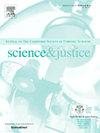Forensic significance of condom traces in sexual assault investigations: A systematic review
IF 2
4区 医学
Q2 MEDICINE, LEGAL
引用次数: 0
Abstract
This systematic review examines the forensic value of condom residue detection in biological samples, particularly in sexual assault investigations where DNA evidence is absent. Following PRISMA 2020 guidelines, a comprehensive literature search was conducted across seven databases (MEDLINE, EMBASE, Cochrane Library, PubMed, Web of Science, SCOPUS, Google Scholar), two trial registers (ClinicalTrials.gov, WHO ICTRP), and four grey literature sources (PQDT, WorldCat, OATD, F1000). Studies published in English from January 1, 2020, to February 28, 2025, were screened using predefined PICO(S) criteria. Eight eligible studies involving human matrices were included. The analytical techniques assessed included DRIFTS-FTIR, ATR-FTIR, Py-GC/MS, GC–MS, and sfPESI-MS. DRIFTS-FTIR demonstrated strong spectral resolution for detecting PDMS-based silicone lubricants, while ATR-FTIR achieved 100 % classification accuracy under controlled laboratory conditions. The combination of spectroscopic and chromatographic techniques (e.g., ATR-FTIR + GC–MS) yielded more reliable and confirmatory results. The risk of bias was assessed using the QUADAS-2 tool for experimental studies and the Joanna Briggs Institute checklist for case reports. Key limitations included small sample sizes, variability in collection protocols, and the lack of validated field methods. Overall, the findings highlight the need for methodological integration and standardisation in forensic lubricant trace analysis. PROSPERO registration: CRD420251004301. No external funding was received.
性侵调查中避孕套痕迹的法医意义:系统回顾
本系统综述探讨了生物样本中避孕套残留检测的法医价值,特别是在缺乏DNA证据的性侵犯调查中。按照PRISMA 2020指南,对7个数据库(MEDLINE、EMBASE、Cochrane Library、PubMed、Web of Science、SCOPUS、谷歌Scholar)、2个试验注册库(ClinicalTrials.gov、WHO ICTRP)和4个灰色文献来源(PQDT、WorldCat、oad、F1000)进行了全面的文献检索。从2020年1月1日至2025年2月28日以英文发表的研究,使用预定义的PICO(S)标准进行筛选。纳入了8项涉及人体基质的符合条件的研究。评估的分析技术包括drift - ftir、ATR-FTIR、Py-GC/MS、GC-MS和sfPESI-MS。drift - ftir显示出很强的光谱分辨率,用于检测pdm基硅树脂润滑剂,而ATR-FTIR在受控的实验室条件下实现了100%的分类精度。光谱和色谱技术的结合(例如,ATR-FTIR + GC-MS)产生了更可靠和验证的结果。使用QUADAS-2实验研究工具和乔安娜布里格斯研究所病例报告检查表评估偏倚风险。主要的限制包括样本量小、收集方案的可变性以及缺乏经过验证的现场方法。总的来说,研究结果强调了法医润滑油痕量分析方法整合和标准化的必要性。普洛斯彼罗注册号:CRD420251004301。没有收到外部资金。
本文章由计算机程序翻译,如有差异,请以英文原文为准。
求助全文
约1分钟内获得全文
求助全文
来源期刊

Science & Justice
医学-病理学
CiteScore
4.20
自引率
15.80%
发文量
98
审稿时长
81 days
期刊介绍:
Science & Justice provides a forum to promote communication and publication of original articles, reviews and correspondence on subjects that spark debates within the Forensic Science Community and the criminal justice sector. The journal provides a medium whereby all aspects of applying science to legal proceedings can be debated and progressed. Science & Justice is published six times a year, and will be of interest primarily to practising forensic scientists and their colleagues in related fields. It is chiefly concerned with the publication of formal scientific papers, in keeping with its international learned status, but will not accept any article describing experimentation on animals which does not meet strict ethical standards.
Promote communication and informed debate within the Forensic Science Community and the criminal justice sector.
To promote the publication of learned and original research findings from all areas of the forensic sciences and by so doing to advance the profession.
To promote the publication of case based material by way of case reviews.
To promote the publication of conference proceedings which are of interest to the forensic science community.
To provide a medium whereby all aspects of applying science to legal proceedings can be debated and progressed.
To appeal to all those with an interest in the forensic sciences.
 求助内容:
求助内容: 应助结果提醒方式:
应助结果提醒方式:


